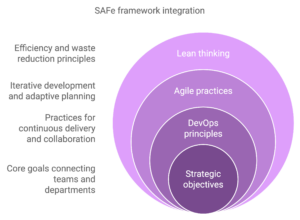Scrum: A lightweight framework for agile teams
Scrum is like a finely tuned sports car—lightweight, nimble, and designed for speed. It’s perfect for teams looking to deliver consistent results through short, focused sprints. Each sprint, lasting two to four weeks, produces incremental updates, keeping progress measurable and feedback loops tight.
Scrum works best on simplicity, with a few key players steering the ship. The Product Owner keeps the backlog clear and prioritized, making sure the team focuses on tasks that matter most. The Scrum Master acts like a pit crew chief, clearing roadblocks and making sure the team follows best practices. And then there’s the Development Team that drives results sprint after sprint.
Scrum ceremonies are the core of this framework. Sprint Planning sets the stage for clear, achievable goals. Daily Stand-ups keep the team synced and adaptable to any obstacles. Sprint Reviews showcase progress to stakeholders, while Retrospectives provide a space for reflection and growth.
For smaller teams or startups, Scrum is generally preferred. It’s easy to implement, empowers team ownership, and prioritizes rapid iteration.
But what about scaling Scrum to larger projects with interconnected teams? That’s where things get tricky. It doesn’t natively support the governance or alignment required for enterprise-level operations. If your project lives in a tightly regulated space or involves multiple layers of oversight, Scrum might feel too light for the job.
SAFe: Scaling agile for large organizations
If Scrum is a sports car, SAFe is the bullet train—designed for large-scale operations, precision, and coordinated progress. SAFe brings agility to enterprises, making it possible for dozens, even hundreds, of teams to collaborate on shared goals. The focus here is on moving fast and smart, with every team aligned to the bigger picture.
At its core, SAFe connects teams and departments to high-level strategic objectives. It integrates Lean thinking, Agile practices, and DevOps principles into one unified framework. Roles like the Release Train Engineer make sure there is strong coordination across Agile Release Trains (ARTs), while ceremonies such as PI Planning synchronize efforts for the next 8 to 12 weeks. These program increments bring structure to the chaos of enterprise-scale projects, so that everyone stays on track.

SAFe framework integration
SAFe’s ability to drive continuous improvement on a broader scale is one of its standout features. Inspect and Adapt sessions take retrospectives to the next level, focusing on system-wide challenges and opportunities for refinement. It’s a framework built for evolution, where even the largest organizations can keep learning and improving.
That said, implementing SAFe is no walk in the park. It requires buy-in from leadership and extensive training across the board. Its layered governance and predefined roles might feel rigid for teams used to autonomy.
For industries like healthcare, finance, or government—where compliance and alignment are strictly enforced—SAFe’s structure is much needed. Think of it as the operating system for enterprise agility: complex to set up, but worth it for the scale and coordination it delivers.
Key differences between SAFe and Scrum
The distinction between Scrum and SAFe comes down to scale, complexity, and focus. Scrum is designed for small, cross-functional teams, typically 5-9 members. It thrives on autonomy and agility, with minimal governance and rapid iteration cycles. It’s perfect for projects where speed and adaptability are key, but it struggles to manage dependencies across multiple teams or align with broader organizational goals.
SAFe, on the other hand, is built for enterprise-level operations. It introduces layers of governance, coordination, and structure for large, interconnected teams to stay synchronized. While Scrum emphasizes delivering working software incrementally, SAFe zooms out to align team execution with strategic business objectives.
Governance is another major differentiator. Scrum champions self-governance, letting teams decide how they meet their goals. SAFe incorporates portfolio-level oversight, aligning projects with long-term business strategies. This added structure can feel restrictive but is necessary for large organizations with complex projects.
In essence, Scrum is a fast-moving sprinter, while SAFe is a well-orchestrated relay team. Both are effective, but they cater to very different environments.
When to use Scrum vs. SAFe
If you’re running a small, focused team working on a product or project with minimal dependencies, Scrum might be your go-to framework. Its simplicity and rapid feedback cycles make it ideal for startups or teams aiming for quick market delivery. Scrum’s short sprints let you stay responsive to user needs and pivot as necessary, keeping the team energized and outcomes clear.
For large enterprises managing complex, interconnected projects, SAFe is arguably the better choice. It’s tailored for scenarios where coordination across departments and alignment with strategic goals are key. Industries like healthcare, finance, or government benefit from SAFe’s built-in compliance and governance features. With program increments spanning 8 to 12 weeks, SAFe offers steady progress while keeping every team aligned with the big picture.
Choosing between the two comes down to scale and complexity. If you’re a startup aiming to disrupt, Scrum gives you the agility to move fast and adapt. If you’re an enterprise with multiple moving parts and stringent oversight, SAFe provides the structure to stay aligned and productive at scale.





